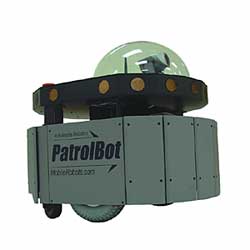Droid Employed
Intelligent rover uses sophisticated sensing and software to perform environmental monitoring, security tasks
 QUESTION: What do you call a robot that can navigate a building's rooms and
corridors on its own, integrating with the facility's infrastructure; responding
to alerts; detecting and reporting possible hazards such as smoke, gas, elevated
temperatures, or intruders; and providing back-up during power outages or other
system failures?
QUESTION: What do you call a robot that can navigate a building's rooms and
corridors on its own, integrating with the facility's infrastructure; responding
to alerts; detecting and reporting possible hazards such as smoke, gas, elevated
temperatures, or intruders; and providing back-up during power outages or other
system failures?
If your answer is R2-D2, computer interface specialist and analysis droid
extraordinaire, then you are correct (and welcome to the Rebel Alliance). If you
base your response in this year and galaxy, and your answer is
PatrolBotTM, facility management and security
droid from ActivMedia Robotics, then you are also correct. And you don't have to
go to Tatooine to find one.
Helping guards monitor remote equipment at companies such as Pfizer Global
Research and optimizing and maintaining the HVAC systems of a server facility at
Hewlett-Packard Labs, the self-guided PatrolBot is an enterprise robot that
operates under either Linux- or Windows-based, Ethernet-ready systems. Its
"brain" is formed of ARCS--ActivMedia Robotics Control System--technology, which
combines sensing, hardware, electronics, and software such as patrol scheduling,
wireless networking, end-user MobilEyes applications, and various
robot-programming utilities.
ActivMedia CEO Jeanne Dietsch says the bot is essentially "a computer on
wheels that can travel to wherever it is needed in a building," operating
autonomously but also accepting commands and information with the rest of the
enterprise through wireless Ethernet. Because its base is programmable, the
droid can incorporate any number of robotic behaviors for particular
applications. ActivMedia is "actively seeking integrators to combine our base
with their testing, security, or sensing equipment," Dietsch says.
Capable of carrying tools, lights, emergency supplies, and other equipment
into an unsafe or dark building, the 70-pound PatrolBot can function as a
utilitarian droid, or as what Dietsch fondly calls a "fetchbot," but with its
array of multifaceted, network-linking capacities, it is being marketed
primarily as an invaluable security and environmental monitoring assistant.
Integrating with a facility's wi-fi network and main air, security, lighting,
and power systems, PatrolBot can scan its work areas and then travel
automatically to perform its surveillance tasks, whether it's mapping
temperatures to improve central heating and cooling efficiency, measuring air
quality, investigating movement in a restricted area, performing range gating,
or enabling remote observation of difficult or hazardous areas. "PatrolBot can
incorporate just about any ambient sensing product," such as gas or particle
detectors, thermal sensors, and RFID readers, Dietsch said. "Any monitor that
can attach to a computer will attach to this," and it can work in tandem with a
facility's fixed sensors, monitoring them for optimal efficiency. During a power
or network failure, PatrolBot can operate stand-alone.
Although small--its CNC aluminum base measures 18 inches wide, 22 inches
long, and 18 inches high--the bot can carry 26 pounds of sensors and
surveillance equipment, travel up to 7 feet per second, traverse cables and
sills of about 1-inch height, and go up and down 15-degree slopes and through
shallow puddles. It can sense obstacles; if a path is blocked, it will attempt
to find an alternate route to its destination.
Eye, Robot
Inside each PatrolBot, enabling its obstacle sensing and
general navigation, is a precision range-finding Laser Measurement System (LMS)
sensor provided by SICK Inc. According to Stacy Kelly, SICK's robotics market
manager, the LMS 200 sensor uses an infrared, class-1 eye-safe laser to scan its
surroundings two-dimensionally and continuously, taking a measurement every half
degree as the PatrolBot moves through a building. "We help provide the 'eyes'
for the robot," Kelly said. "Our sensor uses multiple-point sensing to provide
contour measurement of a room--it shows the PatrolBot what it 'sees,' sends the
measurements to the PatrolBot's onboard computer, and the PatrolBot manipulates
that data into a [three-dimensional] map, which it stores in its memory."
PatrolBot can then share its maps, enabling a fleet of robots to head out with
little notice.
Measurement data from the LMS sensor is available in real time, which,
together with ActivMedia software, enables the PatrolBot to perform its mappings
on-the-fly, navigating to its destination without wires, lines on the floor,
beacons on the wall, or other building modifications. Traveling anywhere within
its assigned territories, following no predetermined path, the bot compares its
current position to its calculated position many times a second and knows at any
given time its precise location and orientation within 2 inches. If office
furniture or even walls in a building are moved, the robot can map the new
layout in minutes.
Another of the PatrolBot's marketed abilities is its capacity to serve as an
adroit receptionist and building tour guide, as Victoria's Secret used it at its
home office in Ohio, making use of ActivMedia's optional, interactive
touchscreen attachment. One of the features facilitating this function is the
PatrolBot's ability to synthesize speech in a male or female voice (or, more
commonly, according to Dietsch, to play recordings of an actor's voice stored in
its droid memory for all conceivable queries and occasions). Presumably, even
R2-D2's familiar streams of chirps and whistles can be stored, if desired.
Available worldwide, PatrolBot is priced at $35,000 and comes complete with
application and utility software and its own docking station, to which it
automatically returns for recharging when its 4-to-6-hour, non-stop battery
needs it. With surveillance accessories, it is $37,500. Custom design,
integration, and programming services are available.
This article originally appeared in the August 2004 issue of Occupational Health & Safety.